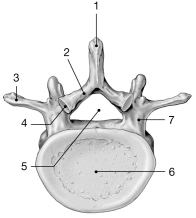A) 1
B) 2
C) 3
D) 4
E) 5
Correct Answer

verified
Correct Answer
verified
Multiple Choice
 Figure 7-1 Floor of the Cranial Cavity
Use Figure 7-1 to answer the following questions:
-Which structure encloses the pituitary gland?
Figure 7-1 Floor of the Cranial Cavity
Use Figure 7-1 to answer the following questions:
-Which structure encloses the pituitary gland?
A) 4
B) 5
C) 6
D) 7
E) 8
Correct Answer

verified
Correct Answer
verified
Multiple Choice
 Figure 7-2 Typical Vertebra (inferior view)
Use Figure 7-2 to answer the following questions:
-Where is the spinal cord located?
Figure 7-2 Typical Vertebra (inferior view)
Use Figure 7-2 to answer the following questions:
-Where is the spinal cord located?
A) 3
B) 4
C) 5
D) 6
E) 7
Correct Answer

verified
Correct Answer
verified
Multiple Choice
The distinguishing feature of a cervical vertebra is the
A) costal facet.
B) vertebral arch.
C) transverse foramen.
D) spinous process.
E) pedicle.
Correct Answer

verified
Correct Answer
verified
Multiple Choice
The internal acoustic meatus is located in which bone?
A) occipital
B) maxillary
C) sphenoid
D) temporal
E) parietal
Correct Answer

verified
Correct Answer
verified
Multiple Choice
Damage to the temporal bone would most likely affect the sense(s) of
A) balance.
B) hearing and balance.
C) smell and taste.
D) vision.
E) touch.
Correct Answer

verified
Correct Answer
verified
Multiple Choice
As the result of an accident,Bill suffers a dislocated jaw.This injury would involve the
A) stylohyoid ligaments.
B) hyoid bone.
C) condylar process of the mandible.
D) alveolar process of the mandible.
E) greater cornu of the hyoid bone.
Correct Answer

verified
Correct Answer
verified
Multiple Choice
The nasal conchae
A) attach muscles that move the eye.
B) contain the nerves for olfaction.
C) create turbulence in the nasal passageways.
D) protect the pituitary gland.
E) attach muscles that move the eyelids.
Correct Answer

verified
Correct Answer
verified
Multiple Choice
Which of the following are distinctive features of thoracic vertebrae?
A) heart-shaped bodies
B) long spinous processes
C) rib articulations
D) no transverse foramen
E) All of the answers are correct.
Correct Answer

verified
Correct Answer
verified
Multiple Choice
Jack gets into a fight and is punched in the nose.Which of the following bones might be fractured?
A) ethmoid bone
B) sphenoid bone
C) temporal bone
D) mandible
E) parietal bone
Correct Answer

verified
Correct Answer
verified
Multiple Choice
The occipital condyles of the skull articulate with the
A) atlas.
B) mandible.
C) first thoracic vertebra.
D) occipital bone.
E) axis.
Correct Answer

verified
Correct Answer
verified
Multiple Choice
The sternum contains
A) the manubrium.
B) the jugular notch.
C) the body.
D) the xiphoid process.
E) All of the answers are correct.
Correct Answer

verified
Correct Answer
verified
Multiple Choice
 Figure 7-1 Floor of the Cranial Cavity
Use Figure 7-1 to answer the following questions:
-Identify the sphenoid bone.
Figure 7-1 Floor of the Cranial Cavity
Use Figure 7-1 to answer the following questions:
-Identify the sphenoid bone.
A) 1
B) 2
C) 3
D) 4
E) 5
Correct Answer

verified
Correct Answer
verified
Multiple Choice
The suture that forms the articulation of the parietal bones with the frontal bone is the ________ suture.
A) lambdoidal
B) rostral
C) coronal
D) squamosal
E) sagittal
Correct Answer

verified
Correct Answer
verified
Multiple Choice
The hyoid bone
A) attaches to tongue muscles.
B) is linked to the styloid process by a ligament.
C) is superior to the larynx.
D) does not directly articulate with other bones.
E) All of the answers are correct.
Correct Answer

verified
Correct Answer
verified
Short Answer
In a fetus,the fibrous membrane spanning developing bones of the skull is called a ________.
Correct Answer

verified
Correct Answer
verified
Multiple Choice
Which of the following is a function of the axial skeleton?
A) provides an attachment for muscles that move the appendicular skeleton
B) provides an attachment for muscles that move the head,neck,and trunk
C) provides an attachment for muscles involved in respiration
D) provides protection for the brain and spinal cord
E) All of the answers are correct.
Correct Answer

verified
Correct Answer
verified
Multiple Choice
Each of the following statements concerning the development of the skull is true,except that
A) all the bones of the skull develop from one single ossification focus.
B) at birth the cranial bones are connected by areas of fibrous connective tissue.
C) the growth of the cranium is usually coordinated with the growth of the brain.
D) the skulls of infants and adults differ in shape and structure of the skeletal elements.
E) the most significant growth of the skull occurs before the age of 5.
Correct Answer

verified
Correct Answer
verified
Multiple Choice
The alveolar process of the mandible
A) supports the upper teeth.
B) supports the lower teeth.
C) anchors the tongue.
D) is part of the temporomandibular joint.
E) articulates with the hyoid bone.
Correct Answer

verified
Correct Answer
verified
Multiple Choice
Which of the following articulate in the mandibular fossa?
A) condylar process
B) mastoid process
C) acromion process
D) coronoid process
E) zygomatic process
Correct Answer

verified
Correct Answer
verified
Showing 61 - 80 of 148
Related Exams